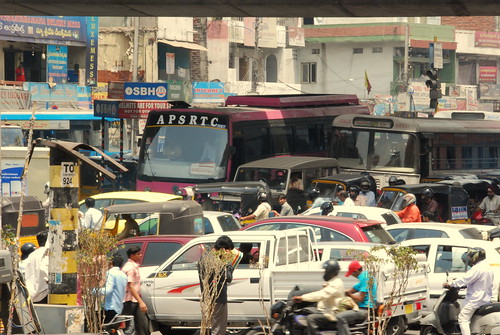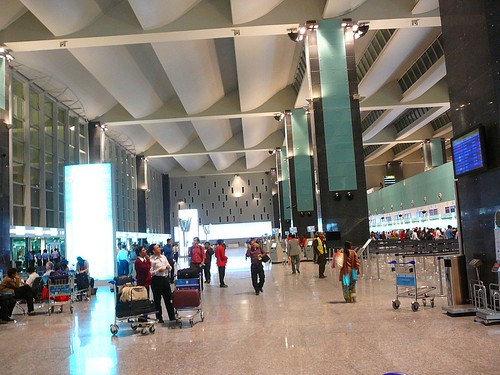Webinar Alert: Advancing Traffic Signal Management Programs through Regional Collaboration – Talking Technology and Transportation (T3) Webinar @ July 23, 2009
Advancing Traffic Signal Management Programs through Regional Collaboration
Date: July 23, 2009
Time: 1:00–2:30 P.M. ET
Cost: All T3s are free of charge
PDH: 1.5. — Webinar participants are responsible for determining eligibility of these PDHs within their professions.
Description
This T3 webinar will explore Regional Traffic Signal Management Programs from an intuitional and organizational perspective. Over the last decade, Regional Traffic Signal Management Programs have developed in many metropolitan areas with the primary objective of improving traffic signal timing. How successful have these programs been at achieving and sustaining this objective? What types of organizational structures, funding, and technology facilitate the operation of the system? There are many approaches to starting, organizing, and sustaining regional programs; a cross section of these, will be explored from the perspective of State DOTs, Metropolitan Planning Organizations and Local Agencies. The activities, funding sources and champions that sustain regional programs are as diverse as the regions themselves; exploring and discussing these is an important step in improving and advancing traffic signal operations nationally.
The webinar will include brief presentations describing each regional traffic signal program followed by a Question & Answer discussion of questions submitted by webinar participants.
Audience
Politicians, managers and practitioners interested in improving traffic signal management, operations and maintenance practices to reduce the impacts of traffic signals on climate change, improve the quality of life of customers and advancing a world class transportation system that interoperates across multiple modes and facilities.
Learning Objectives
- Identify approaches to “sell” regional traffic signal programs as a viable strategy to improve traffic signal operations.
- Identify organizational structures and methods of overcoming institutional barriers to the formation of regional traffic signal management programs.
- List activities that promote regional collaboration among traffic signal operators.
- Identify how planning organizations and agencies that manage and operate traffic signals can work collaboratively to improve traffic signal operations.
- List the benefits of regional traffic signal operations.
- Identify emerging strategies for measuring performance and prioritizing regional objectives and projects.
Federal Host:
Eddie Curtis, FHWA Resource Center & Office of Operations
Eddie Curtis is a Traffic Management Specialist with the FHWA Resource Center and Headquarters Office of Operations. He manages the Arterial Management Program responsible for providing research, guidance and outreach to advance arterial operations and traffic signal management. Via the Resource center Mr. Curtis provides training and technical assistance on issues related to traffic signal management, operations and ACS-Lite. He has 14 years of experience in traffic signal operations and has held positions with the City of Los Angeles and PB Farradyne. He holds a bachelor’s degree in Civil Engineering from California State University Los Angeles and is a licensed P.E. in the states of California.
Presenters:
State Department of Transportation Perspective on Regional Traffic Signal Management
- North Carolina Department of Transportation
Greg Fuller, North Carolina DOT — ITS & State Signals Engineer
- Metropolitan Planning Organization Perspective
Jim Poston, Regional Transportation Commission (RTC)
Metropolitan Planning Organization Perspective
- Ron Achelpohl — Mid-America Regional Council — Operation Green Light Kansas City
Ronald Achelpohl is the Assistant Director of Transportation for the Mid-America Regional Council (MARC). He is responsible for a variety of initiatives related to the funding, operation and management of transportation systems in the Kansas City area including:
-
- Project Manager for Operation Green Light; an initiative to enhance the coordination of traffic signals to improve traffic flow and air quality throughout the region;
- Program Manager for the regional Congestion Management System to ensure that regional decision-makers have solid information about the impacts of congestion as they make major transportation investment decisions;
- Oversight of regional transportation safety programs;
- Oversight of the Regional Intelligent Systems Architecture;
- Oversight of the regional Transportation Improvement Program;
- Oversight of the regional RIDESHARE program; and
- Other initiatives involving Intelligent Transportation Systems, Travel Demand Management, freight transportation, transportation finance and transportation policy.
Ronald has held previous positions in MARC and the Missouri Department of Transportation and has earned a Master of Science, Engineering Management from the University of Kansas and a Bachelor of Science, Civil Engineering from the University of Missouri.
Ronald is a Registered Professional Engineer in Missouri and a member of the American Public Works Association, the Institute of Traffic Engineers, and ITS America, Heartland Chapter.
Professional Organization Perspective
- Institute of Transportation Engineers, Douglas Noble, P.E., PTOE
Douglas Noble is the Senior Director — Management and Operations at the Institute of Transportation Engineers. He is responsible for the integration of transportation management and operations issues into ITE programs and publications. Doug has more than 20 years of experience in project development, financial management and administration in the transportation engineering field with an emphasis in project management, organizational development and change management, traffic engineering, transportation operations, neighborhood traffic management and planned special events.
Doug’s professional background spans both the public and private sectors: He has been the Chief Traffic Engineer for Washington, DC and prior to that a principal transportation engineer for the consulting engineering firm Parsons Transportation Group in its Washington office. He received his bachelor’s degree in civil engineering from Purdue University, and an M.S.E. in transportation systems from the University of Texas at Austin. In addition to being registered as a Professional Engineer, Doug has received certification as a Professional Traffic Operations Engineer™ and is a Fellow of the Institute.









